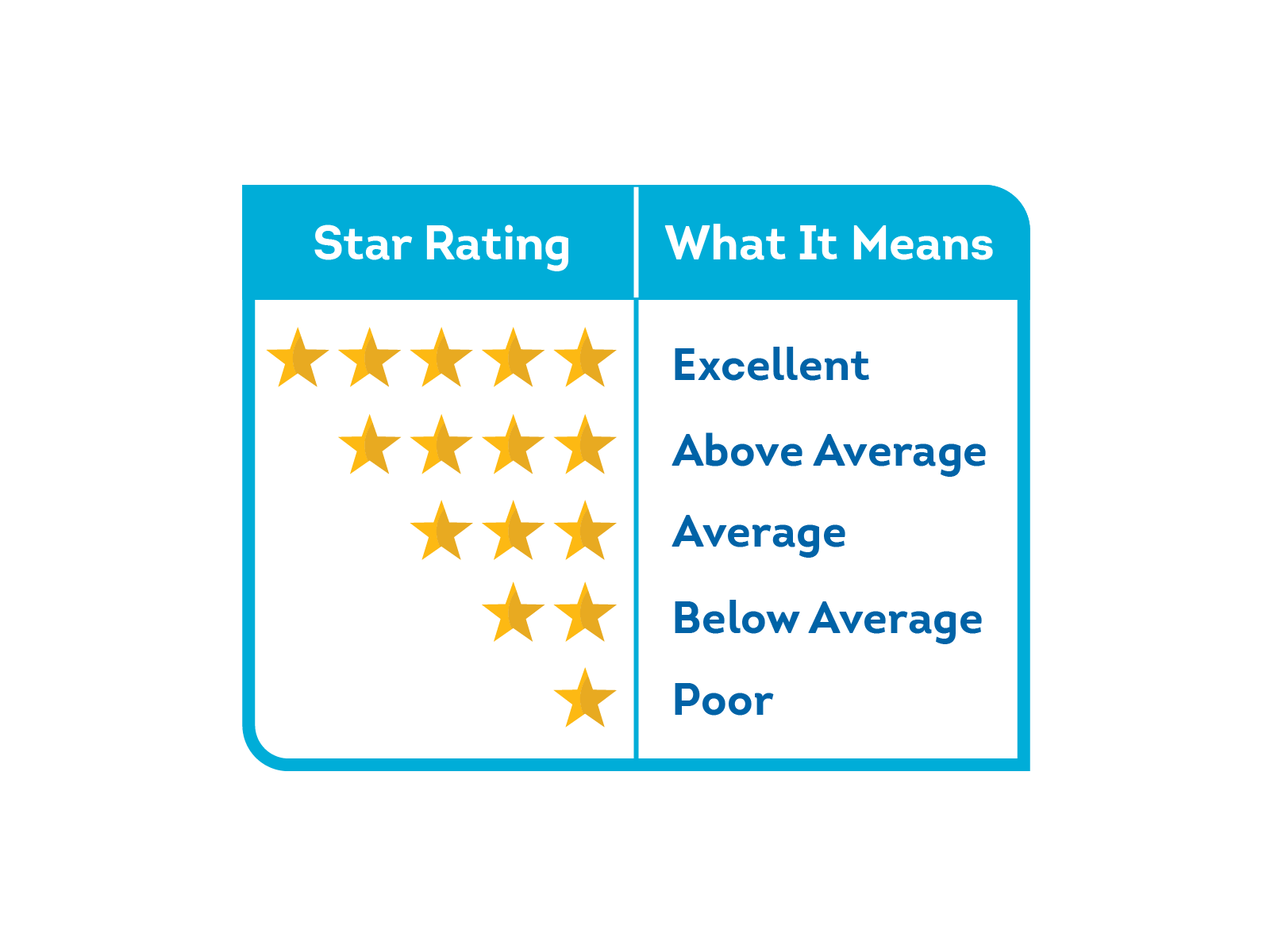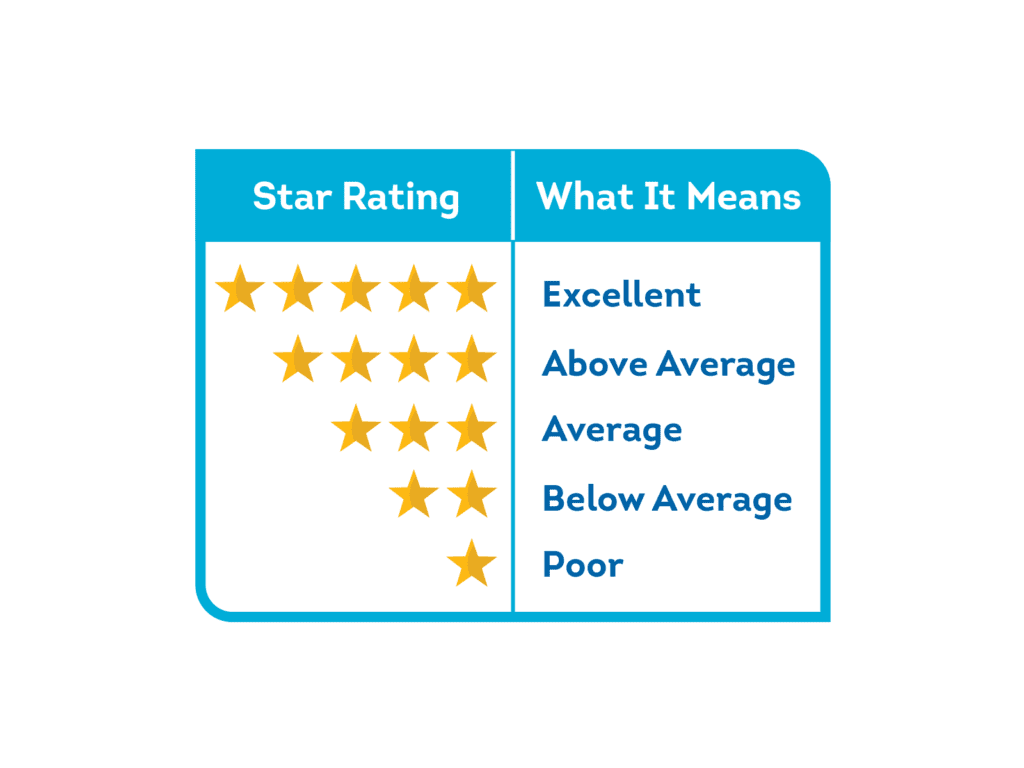Star Ratings
AI overview
What are they?
The ratings are annual quality scores for Medicare health and drug plans.
When are they released?
For 2026, the ratings will be available around October 9, 2025.
Where to find them?
You can use the Medicare Plan Finder tool on Medicare.gov to view the ratings, according to the .
Why are they important?
The ratings inform beneficiaries when choosing a plan during the annual Open Enrollment period, which begins on October 15, 2025.
Higher-rated plans can also receive bonus payments for insurers and larger rebates for beneficiaries. The money doesn’t go as cash payments to members of a plan… it’s used to reimburse the Insurance Company for their costs. So, there may be big changes for 2026.
- Reduced Weighting: The weight for Patient Experience/Complaints and Access measures decreased from 4x to 2x, meaning these measures will have half their previous impact on a plan’s overall score.
- New Measures:
- Kidney Health Evaluation for Patients with Diabetes: A new measure is added to the Star Ratings.
- Improving or Maintaining Physical Health: This Health Outcome Survey (HOS) measure returns with a 1x weight.
- Improving or Maintaining Mental Health: This HOS measure also returns with a 1x weight.
- Increased Importance of HOS: The return of physical and mental health measures signals CMS’s continued emphasis on outcomes measured through Health Outcome Surveys (HOS).
- Shifting Weights: These changes reflect a broader shift in the Star Ratings program towards more quantitative and outcome-based measures. [3, 4, 5, 6]
- Adaptation: Insurers are strategically adapting to these changes by potentially shifting their focus and investing in areas like improving HOS performance.
- Bonus Payments: Plans that achieve at least four stars qualify for bonus payments, which they can use for supplemental benefits or to reduce cost-sharing for members.
- Market Performance: As demonstrated by Humana, plans are seeing shifts in member distribution across star ratings, with a rise in members in 4.5-star plans for 2026, according to Healthcare Dive. [1, 2, 3, 7, 8]
- medicare.gov: You can compare plans and their star ratings side-by-side on the official Medicare website.
- 1-800-MEDICARE: You can call 1-800-MEDICARE to get information about plans and their star ratings. [9]
What are Medicare Plan #Star Ratings?
The Overall Star Rating combines scores for the types of services each plan offers: What is being measured? For plans covering health services, the overall score for quality of those services covers many different topics that fall into 5 categories:
- 2025 Star Ratings released Reuters
- cms.gov/2025-medicare-advantage-and-part-d-star-ratings
- KFF News
- CMS ordered to recalculate xyuhc## 2025 MA stars
A Texas federal judge has sided with xyz in determining regulators messed up calculating its Medicare Advantage quality scores for next year. Learn More
- Staying healthy: screenings, tests, and vaccines: Includes whether members got various screening tests, vaccines, and other check-ups that help them stay healthy.
- Managing chronic (long-term) conditions: Includes how often members with different conditions got certain tests and treatments that help them manage their condition.
- Member experience with the health plan: Includes ratings of member satisfaction with the plan.
- Member complaints and changes in the health plan’s performance: Includes how often Medicare found problems with the plan and how often members had problems with the plan. Includes how much the plan’s performance has improved (if at all) over time.
- Health plan customer service: Includes how well the plan handles member appeals.
For plans covering drug services, the overall score for quality of those services covers many different topics that fall into 4 categories:
- Drug plan customer service: Includes how well the plan handles member appeals.
- Member complaints and changes in the drug plan’s performance: Includes how often Medicare found problems with the plan and how often members had problems with the plan. Includes how much the plan’s performance has improved (if at all) over time.
- Member experience with plan’s drug services: Includes ratings of member satisfaction with the plan.
- Drug safety and accuracy of drug pricing: Includes how accurate the plan’s pricing information is and how often members with certain medical conditions are prescribed drugs in a way that is safer and clinically recommended for their condition.
For plans covering both health and drug services, the overall score for quality of those services covers all of the topics above.
More links
- Study: 87% of Medicare Advantage plans could lose one or more stars in 2023 ratings
- modern healthcare.com/star-ratings-declines
- Improving Your 2026 MA Star Ratings: Insights and Recommendations Managed Health Care.com *
- Health Affairs.org
- Medicare 2020 Part C & D Star Ratings Technical Notes 184 pages
- q1medicare.com
- Fact Sheet on star ratings
- cms.gov/PerformanceData
- Financial Incentives Tied to Medicare Star Ratings: Impact on Influenza Vaccination Uptake in Medicare Beneficiaries
- cms.gov/2025-medicare-advantage-and-part-d-star-ratings
42 CFR Part 422, Subpart D – Quality Improvement
- § 422.152 — Quality improvement program.
- § 422.153 — Use of quality improvement organization review information.
- § 422.156 — Compliance deemed on the basis of accreditation.
- § 422.157 — Accreditation organizations.
- § 422.158 — Procedures for approval of accreditation as a basis for deeming compliance.
details
Part C—MEDICARE+CHOICE PROGRAM
AKA MAPD Medicare Advantage
Legal Codes
- Plain English on Part C – Medicare Advantage
- Sec. 1851. Eligibility, election, and enrollment
- Sec. 1852. Benefits and beneficiary protections
- Sec. 1853. Payments to Medicare+Choice organizations
- Sec. 1854. Premiums and Premium Amounts
- Sec. 1855. Organizational and financial requirements for Medicare+Choice organizations; provider–sponsored organizations
- Sec. 1856. Establishment of standards
- Sec. 1857. Contracts with Medicare+Choice organizations
- Sec. 1858. Special Rules for MA Regional Plans
- Sec. 1859. Definitions; miscellaneous provisions
42 CFR Part 422 – MEDICARE ADVANTAGE PROGRAM
- SUBPART A — General Provisions (§§ 422.1 – 422.6)
- SUBPART B — Eligibility, Election, and Enrollment (§§ 422.50 – 422.74)
- SUBPART C — Benefits and Beneficiary Protections (§§ 422.100 – 422.133)
- SUBPART D — Quality Improvement (§§ 422.152 – 422.158)
- SUBPART E — Relationships With Providers (§§ 422.200 – 422.220)
- SUBPART F — -Submission of Bids, Premiums, and Related Information and Plan Approval (§§ 422.250 – 422.270)
- SUBPART G — Payments to Medicare Advantage Organizations (§§ 422.300 – 422.324)
- SUBPART H — Provider-Sponsored Organizations (§§ 422.350 – 422.390)
- SUBPART I — Organization Compliance With State Law and Preemption by Federal Law (§§ 422.400 – 422.404)
- SUBPART J — Special Rules for MA Regional Plans (§§ 422.451 – 422.458)
- SUBPART K — –Application Procedures and Contracts for Medicare Advantage Organizations (§§ 422.500 – 422.527)
- SUBPART L — Effect of Change of Ownership or Leasing of Facilities During Term of Contract (§§ 422.550 – 422.553)
- SUBPART M — Grievances, Organization Determinations and Appeals (§§ 422.560 – 422.626)
- SUBPART N — Medicare Contract Determinations and Appeals (§§ 422.641 – 422.696)
- SUBPART O — Intermediate Sanctions (§§ 422.750 – 422.764)
- SUBPART P — S [Reserved]
- SUBPART T — Appeal procedures for Civil Money Penalties (§§ 422.1000 – 422.1094)
- SUBPART V — Medicare Advantage Marketing Requirements (§§ 422.2260 – 422.2276)
- Chapter 1 – General Provisions [PDF, 76KB]
- Chapter 3 – Marketing Guides Instructions [PDF, 47KB]
- Chapter 4 – Benefits and Beneficiary Protections [PDF, 522KB]
- Chapter 5 – Quality Assessment [PDF, 387KB]
- Chapter 6 – Relationships With Providers [PDF, 146KB]
- Chapter 7 – Risk Adjustment [PDF, 1MB]
- Chapter 8 – Payments to Medicare Advantage Organizations [PDF, 194KB]
- Chapter 9 – Employer/Union Sponsored Group Health Plans [PDF, 208KB]
- Chapter 10 – MA Organization Compliance with State Law and Preemption by Federal Law [PDF, 44KB]
- Chapter 11 – Medicare Advantage Application Procedures and Contract Requirements [PDF, 294KB]
- Chapter 12 – Effect of Change of Ownership [PDF, 70KB]
- Chapter 13 – Medicare Managed Care Beneficiary Grievances, Organization Determinations, and Appeals Applicable to Medicare Advantage Plans, Cost Plans, and Health Care Prepayment Plans (HCPPs), (collectively referred to as Medicare Health Plans) [PDF, 426KB]
- Chapter 14 – Contract Determinations and Appeals [PDF, 54KB]
- Chapter 15 – Intermediate Sanctions [PDF, 45KB]
- Chapter 16a – Subchapter A – Private Fee-for-Service (PFFS) Plans [PDF, 198KB]
- Chapter 16b – Subchapter B – Special Needs Plans [PDF, 273KB]
- Chapter 17a – Subchapter A – TEFRA Cost Based Payment Processes and Principles [PDF, 132KB]
- Chapter 17b – Subchapter B – Payment Principles for Cost-Based HMOs and CMPs [PDF, 283KB]
- Chapter 17c – Subchapter C – Cost Apportionment for Cost-Based HMOs and CMPs [PDF, 60KB]
- Chapter 17d – Subchapter D – Medicare Cost Plan Enrollment and Disenrollment Instructions
- Chapter 17f – Subchapter F – Benefits and Beneficiary Protections [PDF, 227KB]
- Chapter 18a – Subchapter A – Cost-Based Payment Process and Principles [PDF, 100KB]
- Chapter 18b – Subchapter B – Payment Principles for Cost-Based HMOs and CMPs [PDF, 168KB]
- Chapter 18c – Subchapter C – Cost Apportionment for Cost-Based HMO/CMPs [PDF, 145KB]
- Chapter 21 – Compliance Program Guidelines and Prescription Drug Benefit Manual Chapter 9 – Compliance Program Guidelines [PDF, 289KB]
- Help with File Formats and Plug-Ins
Related Links


https://campaign.poweredbyash.com/october-newsflash-2025